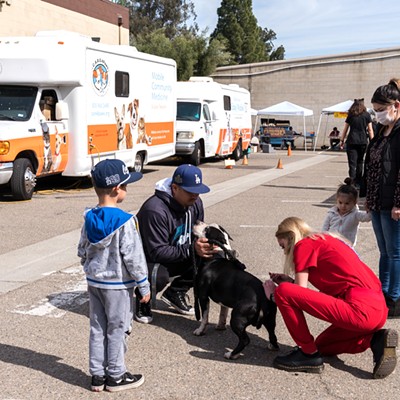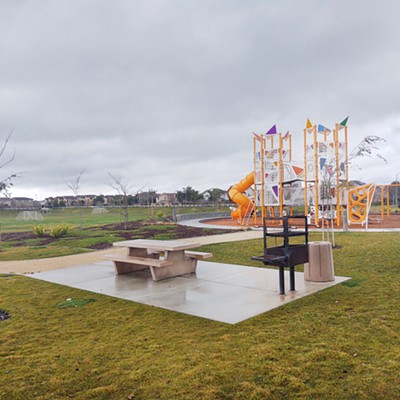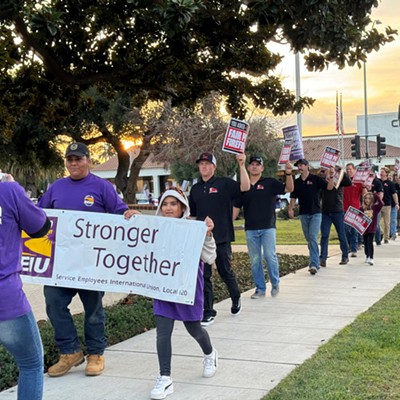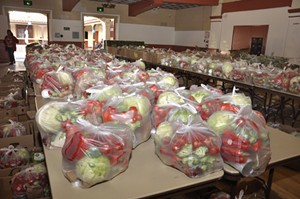
The days of handing out canned food to hungry families are over in Santa Barbara County. Instead, families now receive a grocery bag full of locally grown fruits and vegetables and recipes that teach them how to use the produce.
A water bar set up on one side of the Veterans’ Memorial Community Center courtyard during the July Healthy School Pantry is a testament to where the Foodbank of Santa Barbara County is headed. Floating inside four clear plastic dispensers is a colorful mix of fresh fruit and water designed to be a healthy alternative to soda.
Replacing carbonated sugar-water with strawberry- or cucumber-infused water is one way sponsors of the monthly event hope to educate the families of Bruce and Fairlawn elementary schools and El Camino Junior High School about food.
The neighborhood around the vets’ center is one of the lowest income-generating sets of households in Santa Maria, and many families need foodbank services to put meals on the table. But the pantry isn’t just about giving away food to hungry families.
“It’s all about teaching people to fish rather than just filling their bellies,” said Erik Talkin, Foodbank chief executive officer. “Our goal is to have a new generation of food-literate kids.”
On that third Thursday in July, Foodbank volunteers filled bags with fresh tomatoes, red peppers, salad mix, pears, oatmeal, rice, and raspberries, then lined the goods up on tables in the big hall at the vets’ center. The UC Cooperative Extension demonstrated how to make a fresh fruit salad from ingredients in the bags, and the Santa Barbara County Education Office offered free fluoride teeth varnish applications for kids.
There are currently six Healthy Food Pantries in Santa Barbara County, with plans in the works to open another one. The Foodbank’s newest healthy pantry started in Lompoc this summer, and celebrated its grand opening on Aug. 20. Although the Lompoc pantry doesn’t operate quite like the Santa Maria pantry, the hope is that it will eventually get there, said Judith Monte, the Foodbank’s North County development manager.
Twelve schools collaborate with the Foodbank throughout the county to put on the once-a-month events. In Lompoc, the pantry effort was pushed through city channels rather than the school district. But Monte said the Lompoc Unified School District’s new superintendent showed interest in collaborating while he toured the Lompoc pantry at the Aug. 20 opening.
“It’ll be exciting to see where the community takes the pantry in the year to come,” Monte said. “They are eager to grow it, so it’s on the level of what we have in Santa Maria.”
Superintendent Trevor McDonald didn’t return the Sun’s phone calls before press time.
Community-wide collaboration is a huge part of what makes the pantry in Santa Maria so successful. Various county agencies, the city of Santa Maria, and the Santa Maria-Bonita School District have pulled together and made the Santa Maria pantry about more than just food. It’s about all-around health, an active lifestyle, and access to social services.
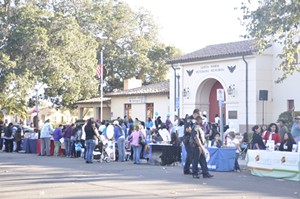
“It very quickly became our most dynamic [pantry], because of the collaboration that came with it,” Monte said.
Participants can take home food and recipes, learn gardening instruction, get health screenings, learn about the plethora of nonprofits that set up booths during the fair, and take an exercise class while they’re at the event.
Feeding America recognized the Foodbank for its program by awarding it the Hunger Hope award in 2012.
The Foodbank piloted its first healthy pantry program three years ago. The idea was to make it about more than just passing out food. It’s part of an all-around effort by the organization to change the way it accomplishes the mission of feeding people in need.
Along with the food pantries come a variety of other programs. Food Literacy in Preschool teaches preschool kids about the positive effects of eating fruits and vegetables versus the negatives of junk food. The Kids’ Farmers Market and Grow Your Own Way are all about teaching families about where food comes from and how to plant an edible garden. Pink and Dude Chefs and Teens Love Cooking teach middle school and high school students how to cook.
Monte said changing the dynamic of how the Foodbank hands out food is an important step toward changing the health in the community.
“Years ago, you know, we just gave people what we could,” Monte said. She refers to a rough time in her life as an illustration of why it’s so important to change the way communities see food. Both Monte and her husband were unemployed for a short period of time and had to rely on the canned and processed goods handed out by their local foodbank.
“You know it was all right for seven months, but in the long run, if it was for 20 years, that’s when we start seeing the health effects,” Monte said. “By providing healthy food and ways to deal with them at home, we can change long-term health and costs.”
THRIVE, a Santa Maria-Bonita School District program that both sponsors and participates in the Healthy School Pantry, has already noticed a difference in students.
Karin Rodriguez with THRIVE said over the last three years there’s a noticeable difference in the body mass index of students from the neighborhood as they enter kindergarten.
“They got healthier,” Rodriguez said.
Statistics from THRIVE show that 8 percent more students entered kindergarten with a healthy body mass index (BMI) in 2012, than did in 2010. In 2010 only 50 percent of students came into school at a healthy weight. The goal is to have 67 percent of students coming into kindergarten with a healthy BMI.
Monte said what they’ve seen so far in Santa Maria is something she hopes can become a model for the Healthy School Pantries elsewhere in the county.
“It’s a real testimony to what a community can do to join together to address a major problem,” Monte said. “That Healthy School Pantry is the most synergistic collaborative effort I’ve ever seen. It’s not one plus one plus one, it’s really an exponential return.”
Contact Staff Writer Camillia Lanham at [email protected].


